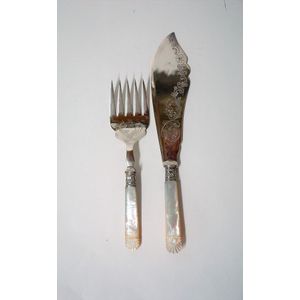Georgian Sterling Silver Teapot Stand with Greek Key Pattern
You must be a subscriber, and be logged in to view price and dealer details.
Subscribe Now to view actual auction price for this item
When you subscribe, you have the option of setting the currency in which to display prices to $Au, $US, $NZ or Stg.
- Sterling Silver - Sterling silver is a mixture of 92.5% pure silver and 7.5% of another metal, usually copper. Fine silver is 99.9% pure silver, and is relatively soft and the addition of the very small amount of copper gives the metal enough strength and hardness to be worked into jewellery, decorative and household objects.
- Greek Key Pattern - The Greek key pattern is a decorative design that consists of continuous interlocking vertical and right-angled lines that form a repeating motif. It is also known as "Meander" or "Greek fret." The pattern is thought to have originated in ancient Greece, where it was used in various decorative arts, such as pottery, metalwork, and architectural elements. The Greek key design is widely used in a variety of contexts, including classical architecture, decorative arts, furniture, interior design and textiles. The pattern is considered timeless and classic, and its geometric simplicity makes it a popular choice for designers in many different fields.
- George Iii - George III (1738 - 1820) was King of Great Britain and Ireland from 1760 to 1820.
- Hallmarks - A mark stamped on articles of precious metals in Britain, since the 14th century, certifying their purity. It derives its name from the Guild Hall of the Goldsmiths' Company, who recieved its Charter in 1327 giving it the power to assay (test the purity) and mark articles of gold and silver.
The hallmark will consist of several marks, including the:
- silver standard mark, indicating the purity of the metal. Sterling silver is .925 pure silver.
- the city mark indicating the city in which it was assayed eg London, Birmingham, York etc.
- the date mark, usually a letter of the alphabet in a particular font and case,
- a duty mark, indicating whether duty had been paid to the crown, and only in use from 1784 to 1890
The piece may include an additional mark, the maker's mark, although not forming part of the hallmark, will be located in the vicinity of the hallmarks.
Sometimes silver plated items will bear faux hallmarks, often confusing those not familiar with silver markings.
This item has been included into following indexes:
Visually similar items

Pair of Japanese Imari porcelain vases, 22 cm high (2)

Georgian Irish hallmarked sterling silver shaped circular salver with shell and scroll rim and engraved with a crest, Dublin, 375g

A pair of early 20th century mother-of-pearl handled and silver plate fish servers, carved and engraved detail.

A Georgian sterling silver oval teapot stand on four reeded feet with similar border and bright cut floral decoration with crest. Peter & Ann Bateman. London, 1813. Width 18 cm
